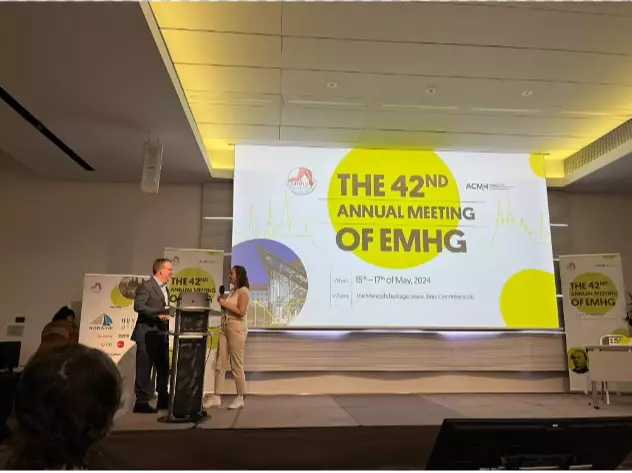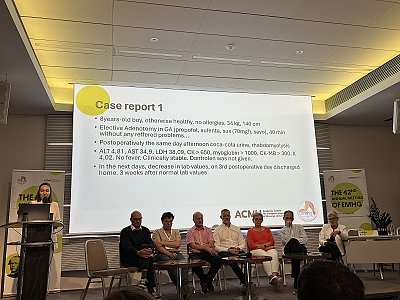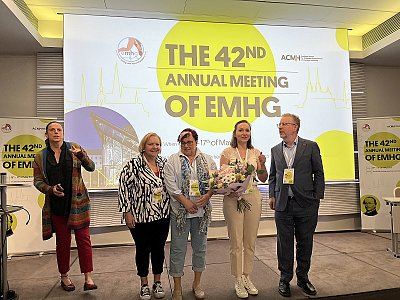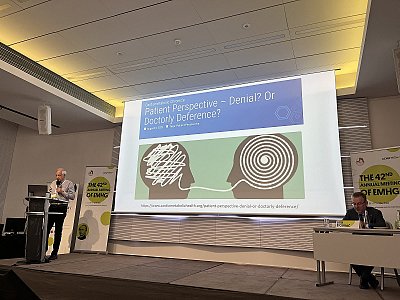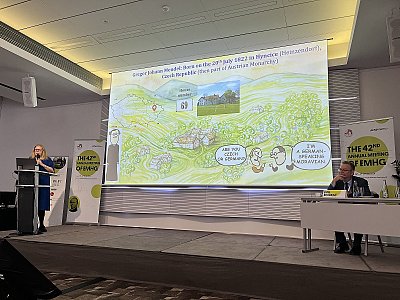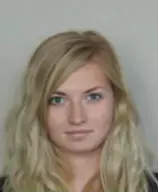The whole meeting started on Wednesday afternoon in the Simulation Centre of Masaryk University (SIMU), where, in addition to the meeting of the EMHG Executive Committee, two workshops and tours took place. The first workshop was a "traditional" hands-on simulation; participants could try managing the three scenarios themselves. The second workshop focused on teaching was a special one also for SIMU, as for the first time, we used a video-streaming demonstration right from the operation theatre, where a trio of 5th-year medical students grappled with managing the malignant hyperthermia (MH) crisis. The subsequent debriefing and moderated discussion then took place directly in a room full of MH experts, who appreciated the braveness of students and modern and effective teaching techniques. In the end, a beautiful sunset during the welcome buffet on the roof of SIMU added to the right atmosphere. The following two days, the congress moved to the Hotel International, in the centre of Brno, where all the scientific sessions and discussions were happening.
On May 16, the Meeting was officially opened at the International Hotel in Brno. The local organisers, Martina Klincová and Petr Štourač, together with the current Czech senator Roman Kraus welcomed everybody and recalled the beginnings of MH testing in Brno and the establishment of the in vitro contraction test (IVCT) laboratory, which has been working for more than 20 years.
The scientific part started with an IVCT masterclass organised by EMHG Young Members. The IVCT guidelines were mentioned followed by a lecture focused on IVCT troubleshooting. A rich discussion afterwards helped to address several problems. For the honorary guest lecture, Professor Šárka Pospíšilová (Masaryk University, Brno) was invited. She captivated the audience, especially by telling the story of the genome analysis of Johan Gregor Mendel himself. The successful genome sequencing was possible thanks to Mendel's hair found in his book and fellow Augustinians' careful storage of his personal belongings, including his very own glasses. She also mentioned many interesting facts from his life, which she correlated with a genetic finding - for example, his predisposition to getting up early, stress anxiety, or she also "genetically verified" his physical appearance well-known from paintings.
In the spirit of genetics, the further scientific sessions continued. Dagmar Štěpánková (Brno, Czechia) introduced the new MH patient registry used within the Academic Centre for Malignant Hyperthermia of the MU Faculty of Medicine. Thierry Girard (University of Basel, Swiss), currently chairman of the EMHG Executive Committee, recalled the Malignant Hyperthermia Event Registry available on EMHG websites (https://www.emhg.org/mh-events-registry), where MH centres can record past and suspected MH episodes.
The end of the day was devoted to genetic testing of MH. Even though there is a rising number of detected variants in the genes RYR1, CACNA1S and STAC3, the variants of unknown significance are still very difficult to interpret. The last lecture by Phil Hopkins (University of Leeds, UK), currently the president of the EMHG Executive Committee, also indicated the importance of searching for other pathogenic variants even in completely different genes than have been studied so far. It is also necessary to take into account the possibility of the existence of protective variants or the adding effect of multiple variants and to assess the possible "susceptibility" to the MH phenotype as a whole. After scientific presentations, the program continued with a guided tour of the Mendel Museum and a gala dinner in the reconstructed Mendel´s greenhouse.
The last day started with a section of clinical lectures from around the world. The team led by Helga da Silva (Universidade Sao Paolo, Brasil) gave two lectures dedicated to their group of MH patients. The first described the higher incidence of joint dislocations, the second suggested a contribution of androgens and excitation drug abuse to the MH reactions in MHS patients. Afterwards, two cases of MH crisis from the MHAUS were presented. Dorothea Hall described problems the USA is struggling with within MH diagnostics, especially the testing and follow-up of patients whose expenses are not covered by insurance. She emphasized the need for greater access to IVCT and genetic testing. The next scientific session was mainly devoted to laboratory research. The block of presentations was opened by Thomas Joseph (USA) with a very interesting talk about the binding sites of propofol on the RYR1 receptor and its probable inhibitory effect. His lecture was awarded as the best research lecture of the EMHG meeting. A possible new pathogenic variant in CACNA1S was presented by Yuko Noda from Hiroshima with a very interesting physiological analysis of myotubules obtained from a MH patient. The group from the University of Leeds described new functional results of genetic variants in CACNA1S and they also presented new results in animal models with STAC3 variant. Thanks to these results, it will hopefully be possible to better understand the pathophysiology of some myopathies and MH in the future. The last lecture of this block devoted to elastography (measurement of muscle stiffness) in patients with MH was also very interesting. Although this method is not considered diagnostic, it can still provide promising data. This lecture by Benedikt Lother (Germany) won the best clinical lecture of the meeting. The second honorary guest lecture was excellently delivered by Professor Robert Dirksen from the University of Rochester Medical Center, New York, USA. His presentation was devoted to the influence of increased ambient temperature and humidity on susceptibility to MH. He very engagingly described the experiments on rats and his results, where it seems that the surrounding environment can really play a significant role. Although further research is needed for application to human medicine, according to the subsequent discussion and a few presented case reports, this theory seemed to be relevant.
The last part was devoted to research in non-invasive MH diagnostics, which is now being carried out in cooperation with many centres around the world. Helena Kim (University of Vienna, Austria) explained the possible use of the metabolome and presented pilot data. Afterwards, the procedure on a homozygous animal model of a pig with a mutation in RYR1 and news on biomarkers were presented. There is still a long journey in front of us, however, the possibility of lower invasiveness of MH diagnostics sounds promising.
The panel discussion organised by EMHG Young Members at the end was a very friendly culmination of the entire congress. Mainly because of a rich discussion on sometimes uneasy questions. Medicine is not just black and white. After the General Assembly and Awards, the final words were devoted to congratulations to the local organisers for the wonderful meeting and special thanks to all who have come. Next year, all are invited to Cape Town, South Africa on April 23-25, 2025.
